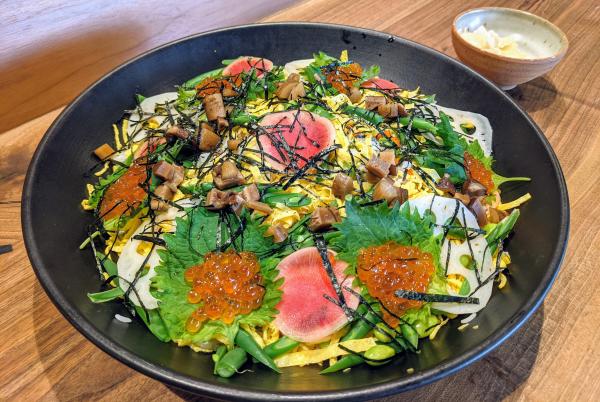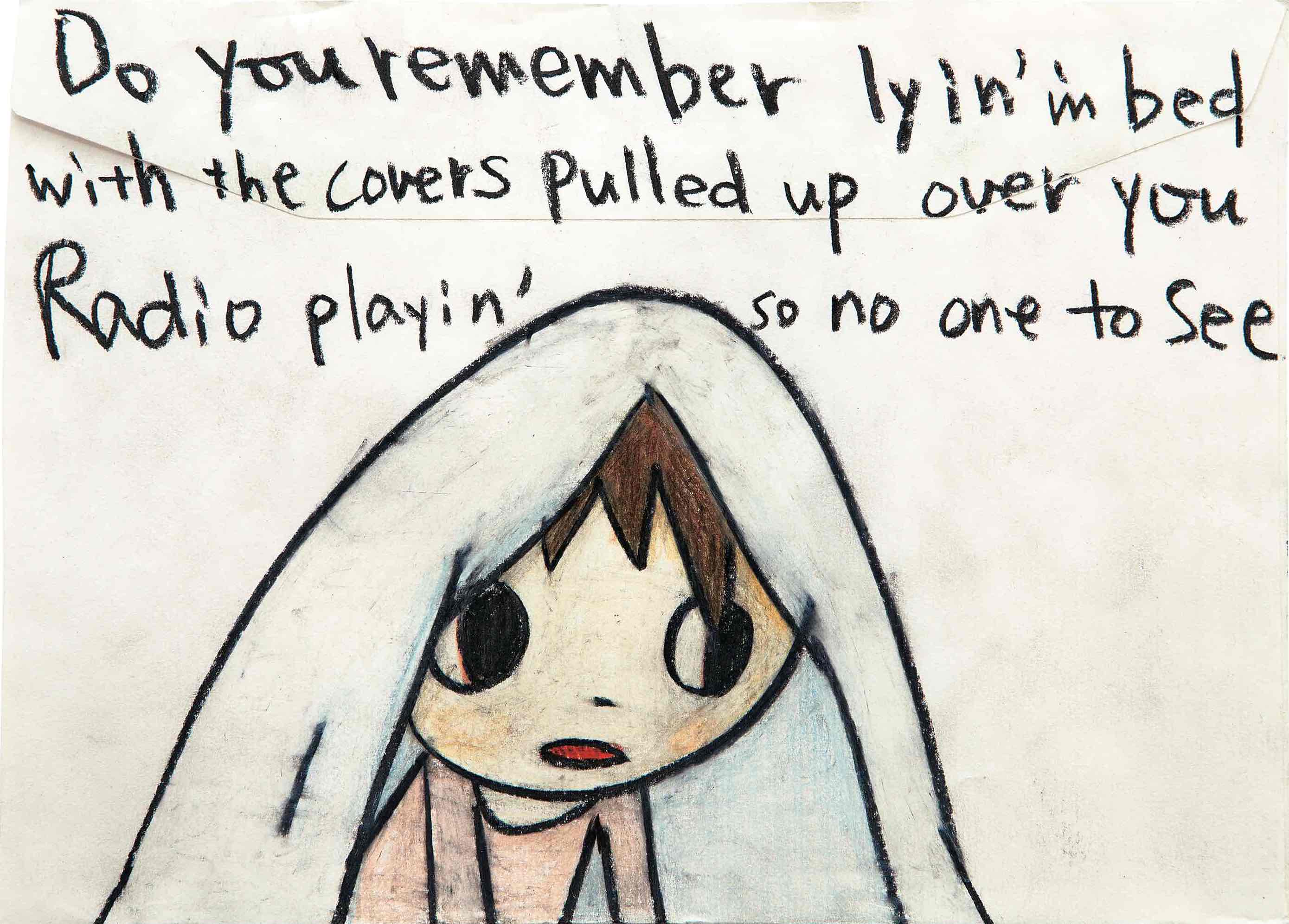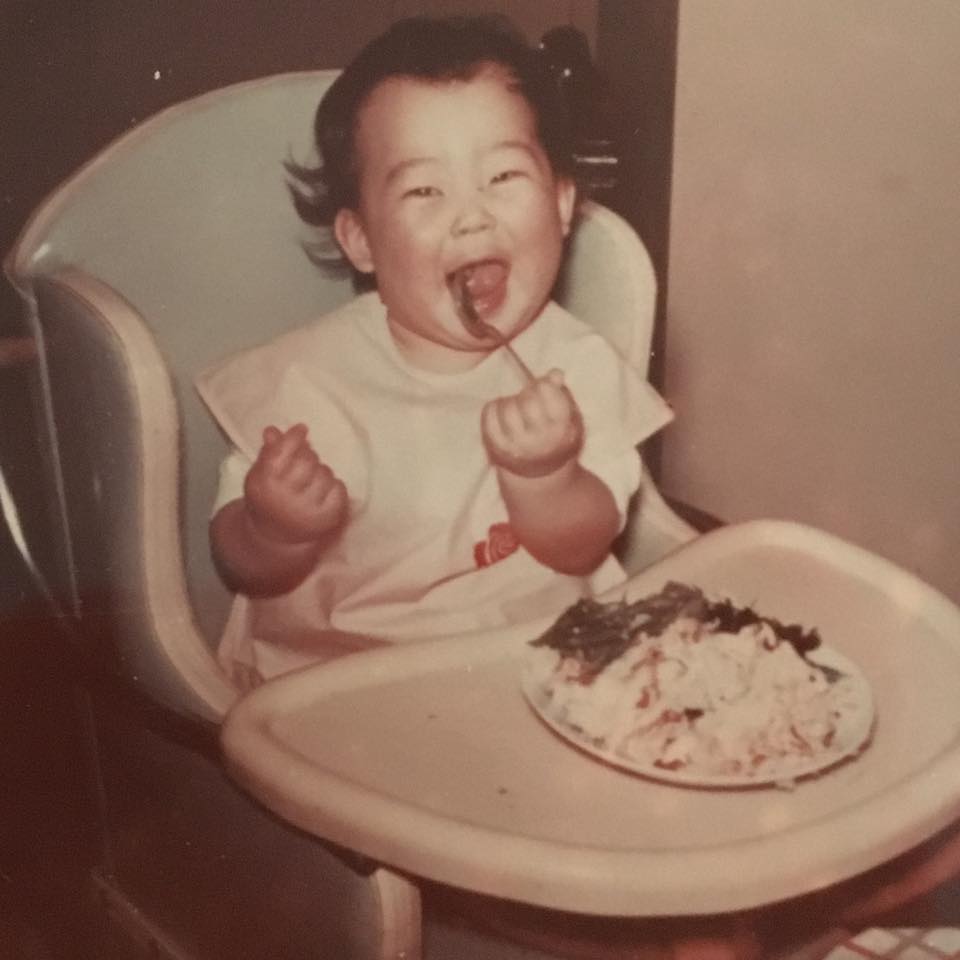Cooking with LACMA is a series that invites chefs and culinary historians to teach recipes inspired by artworks at the museum.
This quarter, we partnered with the Japanese American Cultural & Community Center (JACCC) located in Little Tokyo Historic District, Los Angeles to present a cooking demonstration with Sonoko Sakai, author of award-winning cookbook Japanese Home Cooking. This project dives into the theme of childhood in the exhibition Yoshitomo Nara, from both art and food perspectives.
This drawing, Untitled, of a kid hiding under a blanket and listening to the music from the radio, draws on an experience from Nara’s youth. Nara's childhood home in Hirosaki was close to an American military base, which exposed him to American music, including folk, rock and other genres. He could not understand the English lyrics at the time, but immersed himself in the melody and rhythm. He discovered how music can convey deeply emotional qualities, and finds parallels in the art he creates today. Moreover, the diverse album covers became his first exposure to art. As Nara has said, “Album covers were the first things that spoke to me as works of visual art. For me, having been brought up in a rural area where there were no museums, this was my very first art experience.” To this day, his early experience with music has been influential to his conceptual process.
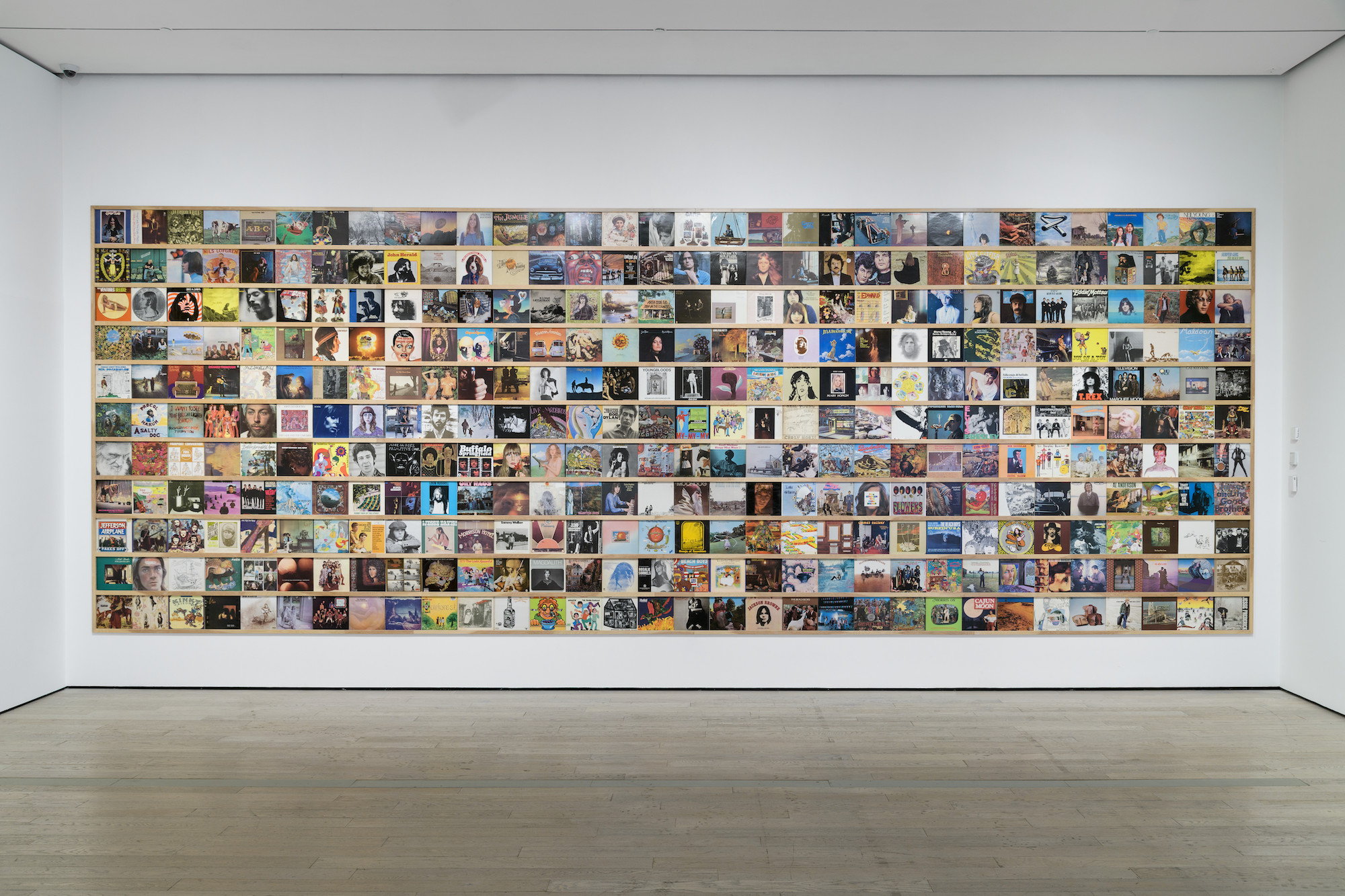
To echo the theme of youth in Nara's work, cooking teacher Sonoko Sakai demonstrates how to make chirashi zushi (scattered sushi), a rice-based dish topped with colorful, seasonal ingredients that can be the centerpiece of a festive meal or enjoyed on a daily basis. It is a dish families in Japan make to celebrate Girl’s Day, when they pray for the good health and happiness of girls. Chirashi zushi was also something Sakai regularly ate as a kid. Because the recipe is highly adaptable, depending on ingredients available at hand, her mother could quickly fix the meal while busy with work.
Sakai includes the five basic colors in her dish: red (ikura salmon roe, carrot), green (green beans, edamame), yellow (egg), white (rice), and black (nori). While Sakai sprinkles colors in food, Nara’s painting explores color in art-making. In Miss Spring, a portrait of a wide-eyed girl he painted after the 2011 nuclear disaster in Fukushima, Nara enters a new direction in his art where he builds up layers of colors to convey emotions. This brushwork invites viewers to look closely at the canvas, revealing a sense of hope and liveliness, as the title suggests. Here, the harmonizing and balancing of colors is an important aspect in both Sakai’s cooking and Nara’s art.
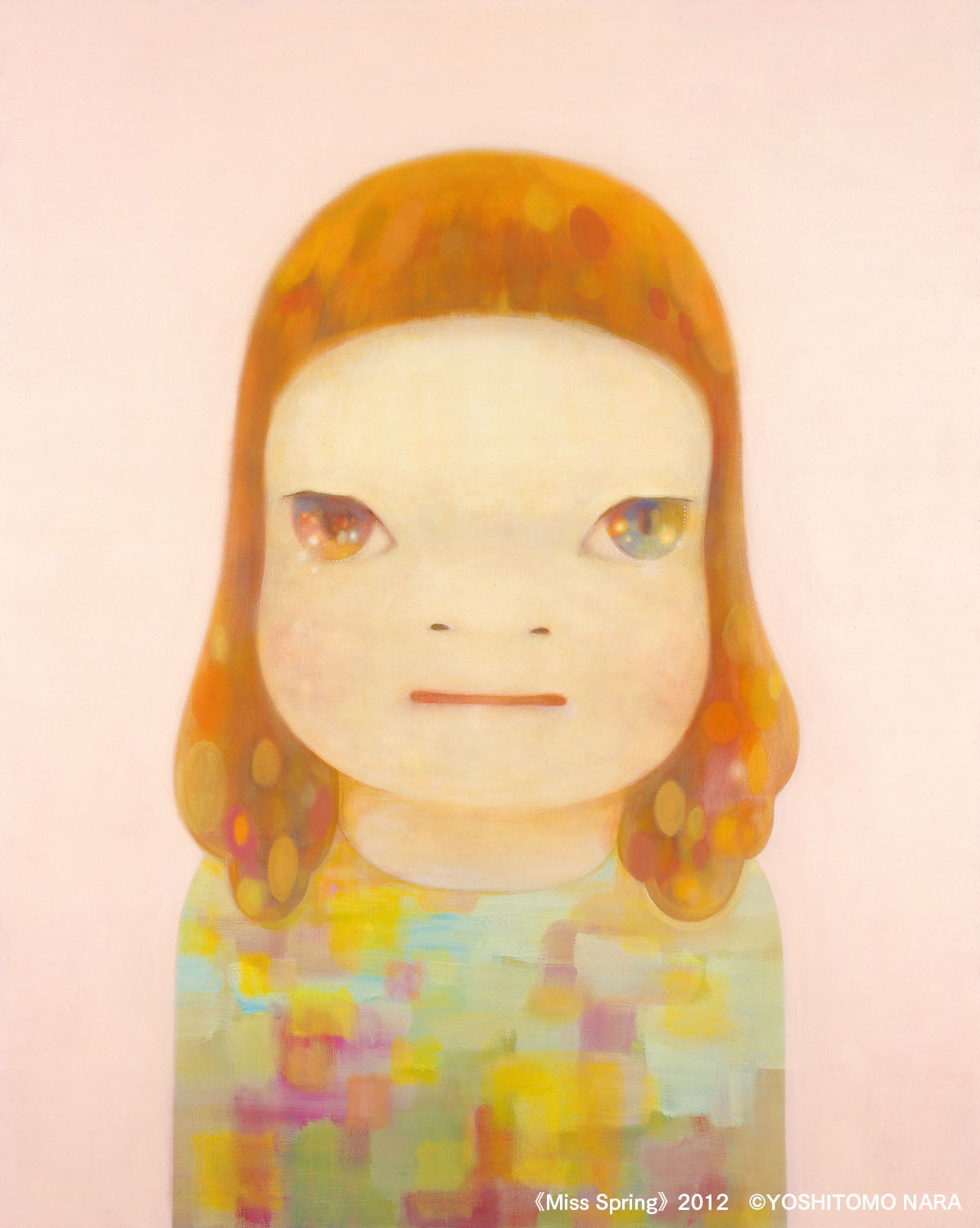
The video Cooking with LACMA: Chirashi Zushi Inspired by Yoshitomo Nara below includes an insightful art talk by Dr. Yeewan Koon, speaking to Nara's upbringing and his painting techniques, as well as a cooking demonstration of chirashi zushi by Sonoko Sakai. Follow along to create your own chirashi zushi at home!
The cooking demonstration was shot at the beautiful Watanabe Culinary Cultural Center at JACCC, which is a new cultural initiative and facility that will highlight Japanese cuisine, culinary talent, food and beverage products.
Recipe for Chirashi Zushi
Key supplies
- One well-seasoned 9-inch cast iron or non-stick skillet
- One large bowl or handai
- One rice paddle or wooden spoon
Ingredients
- 5 dried shiitake mushrooms, soaked for at least 30 minutes (or up to overnight) in 2 cups (480 ml) filtered water and drained, reserving the soaking liquid (DO AHEAD)
- 8 oz. fresh burdock root, unpeeled, scrubbed and chopped into ¼” dice
- 3 tbsp. soy sauce
- 2 tsp. mirin (hon mirin, not ‘mirin-type’)
- 1 tsp. cane sugar
- 1 tbsp. dark brown sugar
- 2 medium carrots, quartered lengthwise
- 3 tsp. salt (this will be split up and used in 3 separate steps)
- 8 oz. (230 g) green beans
- 4 oz. watermelon radish, sliced into thin quarter moons (optional)
- 4 oz. pickled lotus root (optional)
- 4 large eggs, beaten
- 2 tbsp. vegetable oil
- 7 cups freshly cooked white rice
- ⅓ cup (80 ml) unseasoned rice vinegar
- 3 tbsp. (35 g) cane sugar
- 3 tbsp. ginger, peeled and minced
- 20 shiso leaves (or parsley, dill, or cilantro), stems removed, finely chopped
- ¼ cup toasted sesame seeds or toasted pine nuts
- ⅓ cup pomegranate seeds and/or salmon roe (optional)
- 8 oz. seafood and/or sushi-grade raw fish such as cooked shrimp, raw tuna, kampachi, yellowtail, or sea urchin
- 2 sheets nori, cut into ⅛ x 2-inch strips (optional)
- 3 tbsp. olive oil (for drizzling, optional)
- ½ lemon, juiced (for drizzling, optional)
Instructions
-
Prepare the shiitake mushrooms and burdock. Combine the hydrated mushrooms, chopped burdock, and their reserved mushroom soaking liquid in a small saucepan and bring to a boil over medium heat. Reduce the heat to maintain a simmer and add the soy sauce, mirin, brown sugar, and 1 tsp. cane sugar. Stir until sugar is dissolved. Simmer until most of the liquid is absorbed, about 20 minutes. Let cool, then drain. Mince the shiitake mushrooms.
-
Prepare the carrots and green beans. Bring a small pot of water to a boil over medium heat. Add the carrots and ½ tsp. salt and cook until al dente, about 2 minutes. Remove from the water, cool, and mince the carrots. Bring the water back to a boil and add the green beans. Cook for 1 minute, then remove from water, cool, and slice thinly crosswise.
-
Make the egg ribbons. Whisk together the eggs and ½ tsp. salt in a small bowl. In a well-seasoned 10-inch cast iron or non-stick skillet, heat 1 tbsp. of the oil over medium-high heat. Spread the oil evenly over the pan with a paper towel. Add one quarter of the beaten egg mixture and spread it over the pan to make a thin crepe. Cover with a tight fitting lid, turn off the heat, and leave to cook for about 1 minute. The residual heat and the lid will work together to cook the egg crepe through. After a minute, remove the lid and you should find a perfectly set egg crepe. Remove crepe from the pan and set on a cutting board to cool. Repeat with remaining oil and eggs to make 4 crepes. When all crepes have cooled, cut each in half and stack them. Slice the stack into ⅛ x 2-inch ribbons. Set aside.
-
Make the vinegar dressing for the rice. In a small bowl, whisk together the vinegar, cane sugar, and 2 tsp. salt until dissolved. Transfer the freshly cooked hot rice into a large bowl or handai (wooden sushi rice container), and add the vinegar dressing. Toss to combine, moving the rice paddle at a diagonal to avoid squashing the grains. If using a handai, be sure to wet it first, give it a light wipe with a clean kitchen towel, and then add the rice to prevent grains from sticking to the surface.
-
Add the minced mushrooms, carrots, ginger, shiso, and toasted sesame seeds (or pine nuts). Mix gently.
-
Garnish with the egg ribbons, green beans, salmon roe (or pomegranate seeds), and nori strips. Serve immediately. Serve the shrimp or sashimi slices on a separate plate and invite guests to place their own fish on top of their serving of chirashi zushi. If you make the components for the dish ahead, be sure to eat the finished dish within a day, as the sushi rice will harden quickly.



